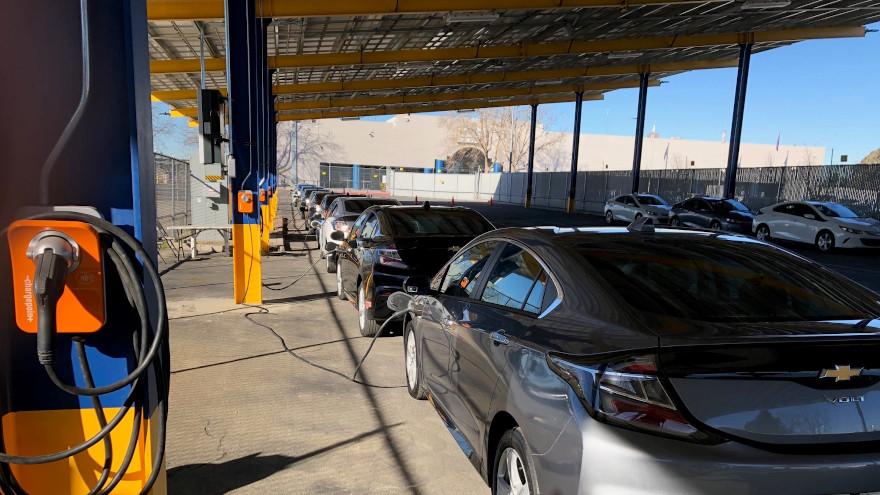Cox Automotive’s preparation for EV surge

File photo of EV charging station at solar carport at Manheim San Francisco Bay. Photo courtesy of company.
Electric vehicle sales are the talk of the town — or at least the auto industry at large and even in the auction lane.
Overall new- and used-vehicle sales fell as 2022 ended, but EVs followed a different path.
During a recent call with the auto industry and media, Cox Automotive cited data from its Kelley Blue Book division indicating that total new-vehicle sales in the U.S. fell to 13.8 million units in 2022, down from 15 million in 2021 and 17.3 million in 2018.
But within the declining new-car market, new EV sales grew in 2022, pushing past the 800,000-unit mark for the first time.
According to Cox data and analysis, there is expected to be more than 1 million new electric vehicles sold in the U.S this year.
In wholesale automotive, Manheim volumes — like most in the industry — lag new-vehicle sales by about three to four years. This potentially means a significant boost to wholesale EV volumes in the future as these models pass through the remarketing lifecycle.
This growth is no surprise to those leading the wholesale market. Manheim and others in the auction business have been preparing for increased EV sales for years, after interest and sales began to pick up since their initial market introduction.
Those in the industry preparing for an influx of used EVs to hit the market are taking it seriously.
For example, Manheim invested almost $100 million last year “to deliver a more connected client experience,” and much of these dollars were put into EV infrastructure and initiatives — preparing the auction for the “EV customer.”
This was reported in a January call to discuss the end-of-year performance in the Manheim Used Vehicle Value Index.
Also, a part of this preparation is plans to create a Manheim- and Cox Mobility-trusted battery health score. And there are already more than 700 chargers across 67 physical Manheim locations.
Grace Huang, president of Cox Automotive’s inventory solutions unit that includes Manheim, spoke on the future of EV readiness and the auction company’s approach.
“As we start seeing more and more EVs arriving at our sites each year, we’ll be sharing battery health information and charging performance data with our clients,” said Huang. “With the battery pack representing up to 40% of the cost of an EV today, we know that having battery diagnostic technology and expertise is critical to properly servicing EVs and accurately assessing vehicle value.”
And in a recent news release from Cox Automotive, the company covered results of the Kelley Blue Book Electric Vehicle Sales Report for Q4 2022, which showed EV sales soaring to record highs in a down market.
New EVs can often be expensive, which has limited sales in the past, but there are signs prices might be coming down to make the new models available to a larger audience, accordign to KBB.
For example, Tesla recently announced significant price cuts. And new models are being presented to the market at a rapid pace. GM is just one automaker promising more “affordable” EV pricing.
High prices don’t seem to be impacting the EV market much. The aforementioned annual sales volume for EVs marks an increase of 65% from 2021, putting EV market share at 5.8%, up from 3.2% last year, KBB said.
Tesla is still the market leader, but the brand’s share of the market is consistently dropping, now below 60%, according to KBB.
What’s in store for the future? KBB called this the “EV Decade,” but acknowledges the market is a long way from becoming an “EV Market.”
But that could be changing. New government-backed incentives and fresh product sets will contribute to EV growth this year, according to KBB.
“2023 will be an important growth milestone for EVs, enabled by more supply,” said Chris Frey, senior manager of economic and industry insights at Cox Automotive, during the recent Manheim Index results call. “There will be 27 new model launches and critical refreshes in 2023, after 19 launches and refreshes in 2022.”
In terms of new-vehicle market share, EV share in 2023 is expected to rise to 8% from around 5%, according to KBB.
EV growth is in part spurred by Federal backing. Cox expects these incentives will encourage more fleet buyers to consider electrified solutions, meaning more used EVs at auction in the years to come.
In fact, a key element of the Inflation Reduction Act was the “reshaping” of EV tax credits in the U.S, Cox points out. Many of the new laws are actually incentives designed to entice fleet operators to consider electrical vehicles in the coming years.
Historically, fleets have been slow adopters of EV technology, but the tides are turning.
According to Cox Automotive, new research indicates 66% of fleet buyers are considering EVs, up from 43% in 2021.
Continued investments and proliferation of charging infrastructure will grow this trend, as well, making EVs a group to watch on the highway, in the lots and in the lanes.

 View The Latest Edition
View The Latest Edition

